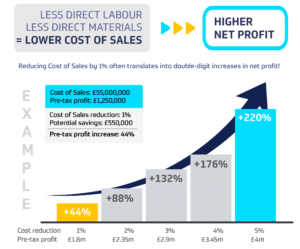Editorials
How can minimised wastage and reduced emissions increase your profit and help our planet?
It’s impossible to do justice to this complex subject within one page. For that reason, I have tried to highlight some of the costs of excess wastage, the production of greenhouse gases and its impact upon climate change.
Many Food and Drink manufacturers, within the UK and beyond, are trying to reduce their Carbon impact to the ideological Carbon Neutral but, as many have already found, it is anything but a quick fix.
Globally, 30% of greenhouse gases come from the production of our food, a third of which is spoilt or wasted. It is estimated that the production, transportation and rotting of that wasted food (over 1.3 billion tonnes) account for 8% of all greenhouse gas emissions. Some estimates put it as high as 16%, but even at 8% this is higher than that created by the entire commercial airline industry.
A Few Facts about Waste
A study by the Food and Agriculture Organisation and others estimates that:
- The amount of food wasted every year is equivalent to more than half the entire global cereal crop.
- Just one quarter of this food spoiled or wasted each year would feed 870 million hungry people in the world.
- Total food production, per capita, for human consumption is about 800kg a year in rich countries, compared to only 460kg a year in the poorest regions – almost double.
- Of this food produced, over 222 million tonnes are wasted in richer countries, as much as the total food production of sub-Saharan Africa.
- Although much food is wasted during the early stages of food supply in lower income countries, in medium to high-income countries this waste occurs mainly at later stages in the supply chain.
For those who love statistics, there is so much more information available online about food waste and the greenhouse emissions caused by its destruction.
Apart from the obvious problem, that we are wasting food that could be used to feed hungry people, there is also the need to minimise the impact of the carbon footprint created from the destruction of waste.
Look how Wealthy I am!
It is easy to see from these few statistics that the more affluent we are, the more wasteful we become and most people didn’t need to be reminded, yet again, of this growing problem. Whatever we do, this difference can never be eliminated because it’s a sad reality that whilst millions of people globally are starving, millions more are so rich they can afford to waste huge quantities and, sadly, buying expensive meals they don’t need is a sign of such arrogance. I read last week about people spending nearly £700 for a steak in a London restaurant. An abuse of wealth?
‘A rich man eats when he wishes, whilst a poor man eats whenever he can.’
Though much is created elsewhere and is outside the manufacturers control there is still considerable wastage within factories, from goods inwards to dispatch, that can be better controlled and reduced.
That old ‘Rock and a Hard Place’ again
Manufacturers are being squeezed from both ends, with higher material and wage costs, but reluctance from their customers, (the retailers) to accept price rises, understandably referred to as ‘Caught between a Rock and a Hard Place.’ However, there is no respite in site from either The Rock or The Hard Place. Annual wage increases are set to continue, as are distribution costs (cue: the need to pay lorry drivers £30 per hour). Raw material prices will also increase due to both the effects of climate change and wage increases within other countries where many of our (especially more exotic) ingredients come from.
Will the retailers become more accommodating about the need for price rises then? Not a chance! They can’t, with the discounters becoming ever more aggressive and increased access to our markets from other low wage economies such as China, India and even Eastern European Countries (ie Bulgaria) they have more suppliers from which to choose.
So, is UK Food Manufacturing doomed in the longer term? Well, maybe, if they continue doing the same old things, whilst expecting better outcomes.
But it doesn’t have to be this way. For decades we have been visiting Food and Drink Manufacturers globally and seen similar problems in most places. This is a global problem. It includes the wastage of raw materials, and the wastage of increasingly costly resources such as labour and energy. Apart from the immediate cost of such wastage there is also the further damage to our planet.
Factories need to become more efficient and waste less.
Easier Said Than Done!
Indeed, it is, but change should begin with a ‘root and branch’ evaluation, coupled with real-time visibility of actual performance. In this way, non-conformances, overfills, poor efficiencies and other forms of wastage become immediately obvious and actionable before they reach the retailer and then become even more costly batch rejections.
Though many of our clients are global, multi-site, manufacturers; many have annually turnovers of £100 million or less. Take, for example, a food manufacturer with a £120m turnover. ‘Cost of Sales’ (which, following general accounting principles, should only include materials and direct labour) may well account for £100m of this. When overheads are taken into account, that £20m gross profit, may be reduced to a net profit of just 1% of turnover or less.
The challenge is to reduce the ‘Cost of Sales’ as every 1% improvement, doubles the initial net profit in the above example.

Being great innovators helps the UK food and drink industry stay ahead, but for a sustainable future we must become more efficient, less wasteful and reduce costs without compromising quality. We have already helped so many companies and are ready to help many more to improve their profits.
Harford Control Ltd, November 2021.
Roy Green
Share your thoughts to Info@harfordcontrol.com or give us a call on +44 (0) 1225 764461




